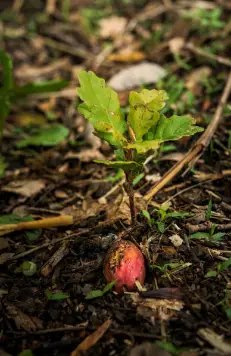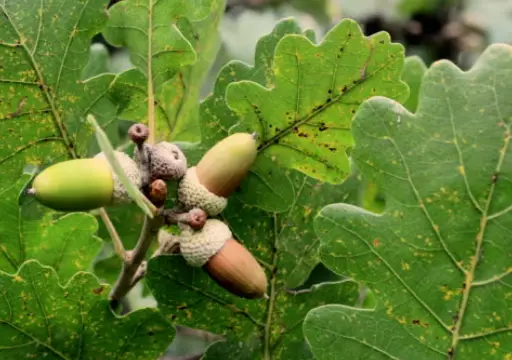The process of growing an acorn from a tiny seedling to a massive oak tree is very remarkable. The small nut that falls from the trees in the fall is the beginning of a process that can take decades or even centuries.
You are not alone if you have ever wondered how a tiny object like an acorn could have the blueprint for such a massive tree. It takes time to grow an oak from an acorn, but it is also an education in the amazing life cycle of these massive trees.
Getting Started with Acorns
The first step is to simply collect some acorns from the ground beneath an oak tree. It’s best to do this soon after they’ve fallen, in late summer or early fall, when they are still fresh. Look for acorns that are plump, free of holes or cracks, and pull away from the cap easily. Avoid any that seem dried out or shriveled.

Grow a Tree From An Acorn
The acorns should be placed in a vented bag or container and refrigerated for a duration of 30 to 90 days. In order to stratify the acorns and enable the seeds to break dormancy, this chilling time is required. The ideal temperature range for this period of time is 33–41°F. They can be ruined if you allow them to become too hot or cold.
Before planting, remove the acorns from the chilling period and allow them to come to room temperature for a few days. It is then time to start developing!
Planting the Acorns
The acorns can be planted directly outside or indoors in pots. Use a potting mix that drains properly in a container with drainage holes if you are planting indoors. The tap roots should be able to grow down 6 to 8 inches in the pots if they are deep enough. With the pointed end facing up, plant the acorns 1 to 2 inches deep.

acorns 1 to 2 inches deep
When planting outside, once the tree is established, select a location that receives full sun exposure. Partial shade, though, might make the seedling more resilient throughout its first year or two. In a 3-by-3-foot area, remove any grass and agitate the dirt. If planting more than one seed, space the acorns 6–8 inches apart and 1-2 inches deep.
Whether planting outdoors or inside, the soil needs to be kept slightly damp but not soggy during the spring germination phase. It could take a few months for the seedlings to emerge, or it could happen in as little as two to three weeks. Take your time!
The First Year
The seedlings require very little maintenance during the first year once they break through the surface. During dry spells, make sure they receive enough water roughly one inch per week. Regular weeding will prevent competition for nutrients and water. relocate indoor plants under bright light or harden off, and relocate outdoor seedlings to a sunny place as too much shadow might result in lanky, poor growth.

The seedlings are establishing a lengthy taproot that will serve as the tree’s anchor for future development and stability. This first season, they might only reach a height of 6 to 12 inches above the ground, but their roots might reach a depth of 1-2 feet below the surface.
If, over the winter, the seedlings appear to cease developing or even drop their leaves, do not be frightened. They will go dormant. This is typical and gives the tree time to recuperate before its spring growth spurt. Just watch out that the soil does not get entirely dry.
Year Two and Beyond
The second year is often when the real growth happens, as the root system is established enough to support a bigger push upwards. The trees may grow 1-2 feet this season!
Staking the young saplings can protect them from wind damage. Drive a sturdy stake or small fence post into the ground near the trunk and use flexible ties to connect the two, avoiding restricting growth.
Fertilizing is usually not needed the first couple years, as the seedlings can thrive on existing soil nutrients. But starting in year 3 or so, applying a balanced fertilizer or compost can give them a boost.
As the years go on, the growth rate may be 1-2 feet per year under good conditions. Pruning lower branches as the tree grows taller encourages an upward growth pattern and discourages excessive lateral branching.
You’ll continue to be patient for a while, as oak trees grow relatively slowly; it can take 20–30 years for an oak to reach its full mature size and height! But with proper care and time, that little acorn will sprout into a beautiful shade tree that can live for hundreds of years.
What to Expect as Your Oak Grows
In 5 years, your oak may reach 6–8 feet tall
At 10 years old, it could be 10–15 feet high
By 20 years, a stately 20–30 foot oak
At 50 years old, an impressive 40-foot mature tree
Beyond 100 years, you have a picturesque, centuries-old oak!

So don’t be discouraged by how tiny an acorn looks—inside that tough little shell are the complete instructions for growing into a majestic tree. With a little patience and care, that acorn can eventually provide plentiful shade, habitat for wildlife, and turn a simple yard into a true arboretum. Getting to watch that transformation over the years is one of the joys of nature!
Growing Tips for Success
• Collect fresh, undamaged acorns in fall
• Chill them for 30–90 days before planting
• Plant 1-2″ deep with point facing up
• Ensure soil stays lightly moist until germination
• Provide partial shade the first couple years
• Weed consistently and water during droughts
• Prune lower branches as tree grows taller
• Have patience; growth is slow but steady!
It is quite satisfying to nurture that little seed along the way, whether you want to try your hand at growing an acorn as a project with kids or you are dedicated to bringing a gorgeous oak tree to your landscape. Witnessing the annual unfolding of a fresh batch of leaves serves as a constant reminder of the trees’ eternal life cycle. Just remember, the old sayings are true—after all, from tiny acorns do mighty oaks grow!




